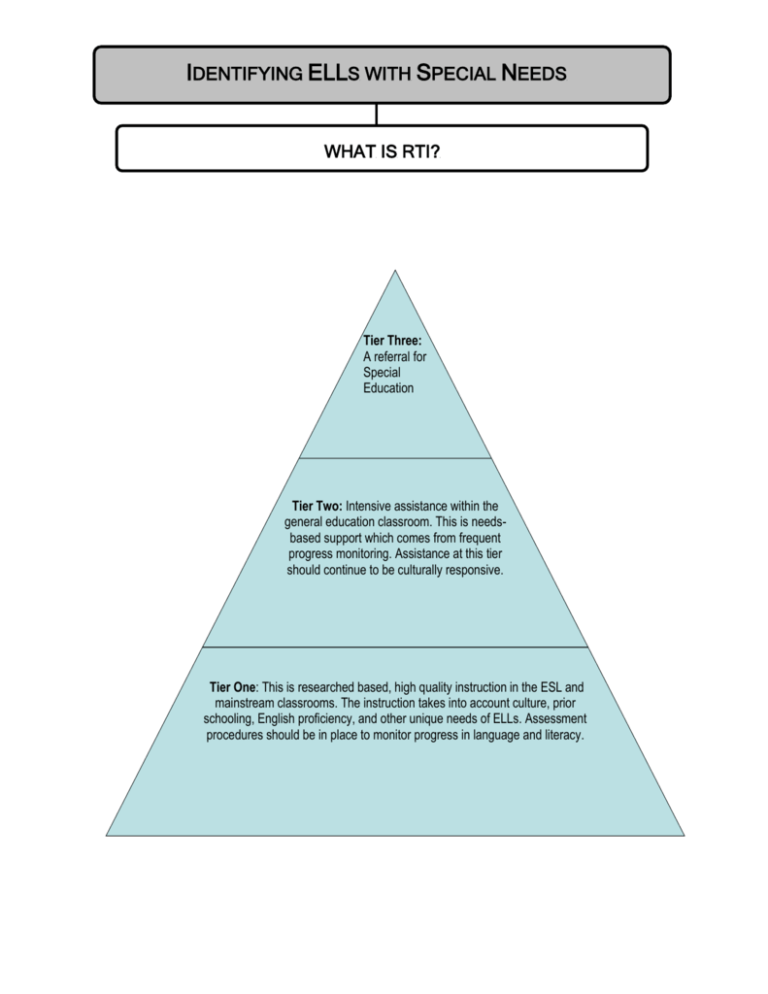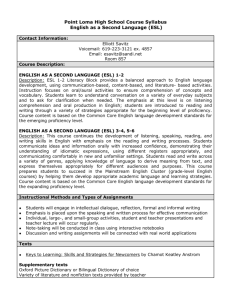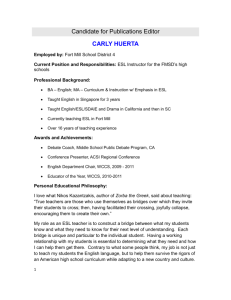A. It is critical that high quality, culturally responsive instruction be
advertisement

IDENTIFYING ELLS WITH SPECIAL NEEDS WHAT IS RTI? Tier Three: A referral for Special Education Tier Two: Intensive assistance within the general education classroom. This is needsbased support which comes from frequent progress monitoring. Assistance at this tier should continue to be culturally responsive. Tier One: This is researched based, high quality instruction in the ESL and mainstream classrooms. The instruction takes into account culture, prior schooling, English proficiency, and other unique needs of ELLs. Assessment procedures should be in place to monitor progress in language and literacy. IDENTIFYING ELLS WITH SPECIAL NEEDS CONSIDERATIONS FOR RTI REFERRAL A. It is critical that high quality, culturally responsive instruction be implemented at Tier One. B. The referral should be based on comparisons of academic progress among ELL peers. Data from standardized assessments needs to inform any such decision. A key question to consider: Are all of the ELLs struggling, or only a handful, on these assessments? C. For Tier One and Tier Two interventions, the instruction should be explicit and provide structured opportunities to practice English in all domains. D. Incorporating language acquisition theory and ESL instructional strategies are essential at every tier of RTI or any data could be invalidated. E. ESL teachers should be consulted on any decision to refer an ESL student. Please notify the ESL office when referring students to various tiers. F. All procedures, notices, and explanations to parents must be translated. Please contact the ESL Office for an interpreter or to assist with a document translation. 2 CONSIDERATIONS FOR RTI REFERRAL Characteristics When attempting to distinguish the difference between an ESL student and an ESL student with a disability, the following facts should be considered: 1. the degree of disability present can vary depending on the student’s processing skills and cognitive level; 2. many children stop speaking their first language when they begin speaking English. When this happens, lack of further development in the first language should not be considered a language learning problem. It is symptomatic of the system’s effect on the student, not due to a physiological state within the student; 3. the student with a disability may learn English at a much slower rate than a non-disabled student; 4. students with language disorders tend to exhibit the same kinds of problems in their native language. Characteristics of ESL Students With and Without a Disability Characteristics ESL Student ESL Student with a Disability Cause of Perceived Problem Extrinsic. Adaptation process to environment Intrinsic. Physiological in nature Social Abilities/Affective Factors Demonstrates appropriate social skills for home country. May have some social problems due to lack of familiarity with American customs, language, and expected behaviors. May experience social isolation and is likely to be a follower rather than a leader in an English speaking group. Student may tend to interact with more pupils from own cultural group. May exhibit behavioral problems not attributable to adjustment and acculturation; may have difficulty forming appropriate social relationships; may have frequent fights or arguments. 3 Characteristics ESL Student ESL Student with a Disability Communication Skills Normal language learning potential. Demonstrates ability to achieve communicative competence in first language. Initially, the communicative use of English is less than native speaker’s ability and native speakers easily note this. Errors are not attributed to a speech/language disability, but rather to lack of ability in the second language. Eventually, the student communicates proficiently in the second language. May not achieve communicative competence in either first or second language. Speech language disorders exhibited in the areas of articulation, voice, fluency, or receptive and expressive language. Language Skills First language is appropriate for age level. Nonverbal communications skills (such as eye contact, response to speaker, clarification or response, turn taking, etc.) are appropriate for age level. Student may not know specific vocabulary, but he or she may be familiar with item or concept. Sentence structure and grammar are appropriate for age. English language acquisition corresponds to that expected based on the student’s length of time in English speaking schools. Student may demonstrate a loss of receptive and expressive language skills in first language when exposed to second language. First language is not appropriate for age level in one or more of the following areas: vocabulary, word finding, following directions, sentence formulation, and/or pragmatics. Student will not learn English at the same rate as student without disability. Nonverbal communications skills are not appropriate for age level. Student may not know specific vocabulary, but he or she may be familiar with item or concept. Sentence structure is shorter or disordered, and grammar is incorrect for age. English language acquisition does not correspond to that expected based on the student’s length of time in English speaking schools. Subtle signs of a language disorder: disorganization, difficulty with spatial and temporal concepts and language, disorganized thoughts, poor sequencing of stories. 4 Characteristics ESL Student ESL Student with a Disability Academic Functions Normal language potential. Apparent problems due to culturally determined life style or lack of schooling in home country. Significantly below grade level performance may be due to inability to make progress in second language acquisition or difficulty retaining academic information despite a variety of interventions; history of academic difficulties in home country or first language. Cognitive Abilities Cognitive abilities are usually normal. Students usually score better on nonverbal sections of cognitive tests and their scores on the verbal portion of the tests increase over the years. Verbal and nonverbal abilities are inconsistent or significantly low. Students score better on nonverbal sections of cognitive tests and their scores on the verbal sections of cognitive tests and their scores on the verbal sections of the tests do not increase steadily over the years. English-normed tests must be interpreted with caution. Nonverbal performance should be conducted. Progress Progress in home language is contingent upon adequacy and continuation of first language instruction. (During the language transition period, first language skills may decrease due to lack of continued instruction in first language.) Academic progress in English is dependent upon the quality and quantity of English instruction. English progress should continue steadily even if slowly. May show less than expected progress in English acquisition and development of academic skills. May show a marked discrepancy between different areas (such as oral and writing skills) which cannot be attributed to lack of sufficient time or appropriate interventions. 5 Characteristics ESL Student ESL Student with a Disability Health No significant health characteristics. Consider developmental factors with regard to cultural context. History of risk infancy, ear infections, or hearing problems, sleep or eating disturbances, incontinence, and family incidence of health disability may have influence on learning. Sensory Functioning May exhibit periodic “overload” response such as gazing off and blanking out what is heard for short periods of time during an initial adjustment to new setting. Auditory or visual processing difficulties exhibited over period of time without signs of improvement. Motor Skills Normal Exhibits physical impairments. Productivity May have difficulty with verbal and written directions or beginning/switching tasks due to insufficient English development but often finds strategies or techniques for coping. May have difficulty with verbal and written directions or beginning/switching tasks for a variety of reasons and may not acquire strategies for coping; has difficulty completing tasks following explicit instructions. These are characteristics that might be shared by an ESL student with a disability and one without a disability; however, there are different causal variables that determine whether the ESL student has a disability or not. In this initial stage of investigation the concern about a student’s learning is to ascertain whether the causal variables are ESL related. The needs of an ESL student focus on learning another language for social and academic purposes. ESL/SPED students need to learn how to learn and learn how to learn a language at the same time. ESL students need access to English-speaking peers, interactive activities, and challenging content (Rojas, 1998). Courtesy of DODEA 6 IDENTIFYING ELLS WITH SPECIAL NEEDS CONSIDERATIONS FOR GIFTED EVALUATION REFERRAL It is important that English Language Learners should have equal access to gifted programs in the District. ESL teachers, in collaboration with classroom teachers, should refer English language learners to participate in the evaluation for Gifted Programs. 22 PA Code Chapter 342 defines a student who is mentally gifted as an “outstanding intellectual and creative ability the development of which requires special activities or services not ordinarily provided by the regular programs. The term includes a person that has an IQ of 130 or higher and when multiple criteria as set forth in the Pennsylvania Department of Education Guidelines indicate gifted ability.” Kaplan (1982) suggests that students with limited English proficiency who are mentally gifted show their giftedness in ways different from the majority of the student population of the United States. According to Valencia, the characteristics of gifted students with limited English proficiency are as follows: While highly articulate in their native language or dialect, they may be unable to clearly reveal this capability in English; They may be more inhibited in articulating and expressing ideas in the monolingual English setting as compared to situations in their own cultural environment. Perrone and Aleman (1983) suggest four areas for observing students with limited English proficiency: a) Rapid accumulation and assimilation of knowledge in English and the native language; b) Leadership abilities; c) Interpersonal sensitivity, the understanding of verbal (English and the native language) and non-verbal (cultural factors) communications with others; d) Performance in the arts, music, drama and athletics 7 e) Additional considerations that should be made when evaluating whether an ESL student could potentially qualify for the District’s Gifted and Talented program are: Academic skills not dependent on English language (e.g., mathematics calculations, problem solving using visual-spatial reasoning) Review of prior school record and performance including scores on tests in the heritage language Work samples in the heritage language Successful performance and achievement in advanced level work Ability to extend knowledge to new situations or unique applications Aptitude at learning independently, particularly in areas of strong interest LEP students, like non-LEP students, should be considered potential candidates for gifted program and services from the beginning of their school attendance, regardless of their English proficiency. It is not appropriate to wait until the student has mastered or even begun to master English before considering him or her as a possible gifted student. English-language acquisition or proficiency may not be deemed a prerequisite to consideration of gifted programming. The following characteristics often are seen among students in Englishdominant settings who have not mastered the English language yet are intellectually advanced: Successful history in previous school settings in the united States in which instruction was conducted in the student’s heritage (otherwise referred to as “native,” “home,” “dominant,” or “preferred”) language Advanced developmental history based on information provided through parent interview Rapidity of learning Ability to solve problems that are not dependent on English (e.g., putting complex pieces together to make a whole, matching or sorting according to complex attributes, doing mathematical calculations, acquiring non-verbal social cues in the heritage and other cultures to guide behaviors) High academic performance in tasks using heritage language Successful history in environments where heritage language is required 8 Remember that all communication with parents may require a translator to remain in compliance with state and federal guidelines. Assistance with securing a translator can be handled through the ESL Administrative Office. 9





